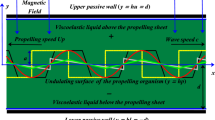Abstract
We have studied a biomimetic swimmer based on the motion of bacteria such as Escherichia coli (E. coli) theoretically and experimentally. The swimmer has an ellipsoidal cell body propelled by a helical filament. The performance of this swimmer was estimated by modeling the dynamics of a swimmer in viscous fluid. We applied the Resistive Force Theory (RFT) on this model to calculate the linear swimming speed and the efficiency of the model. A parametric study on linear velocity and efficiency to optimize the design of this swimmer was demonstrated. In order to validate the theoretical results, a biomimetic swimmer was fabricated and an experiment setup was prepared to measure the swimming speed and thrust force in silicone oil. The experimental results agree well with the theoretical values predicted by RFT. In addition, we studied the flow patterns surrounding the filament with a finite element simulation with different Reynolds number (Re) to understand the mechanism of propulsion. The simulation results provide information on the nature of flow patterns generated by swimming filament. Furthermore, the thrust forces from the simulation were compared with the thrust forces from theory. The simulation results are in good agreement with the theoretical results.
Similar content being viewed by others
References
Bogue R and Partners. The development of medical microrobots: A review of progress. Industrial Robot, 2008, 35, 294–299.
Behkam B, Sitti M. Design methodology for biomimetic propulsion of miniature swimming robots. Journal of Dynamic System Measurement and Control, 2006, 128, 36–43.
Wang Hang G, Li J, Wang Y, Xiao K. A micro robot fish with embedded SMA wire actuated flexible biomimetic fin. Journal of Sensor and Actuators, 2008, 144, 354–360.
Kim Kim D H, Jung J, Park J O. A biomimetic undulatory tadpole robot using ionic polymer-metal composite actuators. Smart Materials and Structures, 2005, 14, 1579–1585.
Fukuda T, Kawamoto A, Arai F, Matsuura H. Steering mechanism of underwater micro mobile robot. Proceeding of IEEE International Conference on Robotic and Automation, Nagoya, Japan, 1995, 1, 363–368.
Zhang W, Guo S X, Asaka K J. A new type of hybrid fish-like microrobot. International Journal of Automatic and Computational, 2006, 3, 358.
Nguyen Q S, Heo S, Park H C, Goo N S, Kang T, Yoon Lee S S. A fish robot driven by piezoceramic actuators and a miniaturized power supply. International Journal of Control, Automation and Systems, 2009, 7, 267–272.
Purcell E M. Life at low Reynolds Number. American Journal Physical, 1977, 45, 3–11.
Holwill M E, Burge R E. A hydrodynamic study of the motility of flagellated bacteria. Archives of Biochemistry and Biophysics, 1963, 101, 249–260.
Chwang T, Wu T. A note on the helical movement of microorganisms. Proceedings of the Royal Society of London, Series B: Biological Sciences, 1971, 178, 327–346.
Mustafa K, Serhat Y. Simulation-based analysis of a biologically-inspired micropump with a rotating spiral inside a microchannel. Proceedings of the Sixth International ASME Conference on Nanochannels, Microchannels and Minichannels, Darmstadt, Germany, 2008, ICNMM2008-62323.
Kim M, Bird J C, Van Parys A J, Breuer K S, Powers T R. A macroscopic scale model of bacterial flagellar bundling. Proceeding National Academy of Sciences of the USA, 2003, 100, 15481–15485.
Hancock G. J. The self-propulsion of microscopic organisms through liquids. Proceedings of the Royal Society of London. Series A: Mathematical and Physical Sciences, 1953, 217, 96–121.
Johnson R E, Brokaw C J. Flagellar hydrodynamics: A comparison between resistive force theory and slender body theory. Journal of Biophysical, 1979, 25, 113–127.
Takano Y, Yoshida K, Kudo S, Nishitoba M, Magariyama Y. Analysis of small deformation of helical flagellum of swimming Vibrio alginolyticus. JSME International Journal Series C, 2003, 46, 1241–1247.
Leifson E. Atlas of Bacterial Flagellation, Academic Press, New York, USA, 1960.
Ha N S, Yoon H K, Goo N S. Development of a propulsion system for a biomimetic thruster. Chinese Science Bulletin, 2010. (to be published).
Author information
Authors and Affiliations
Corresponding author
Rights and permissions
About this article
Cite this article
Ha, N.S., Goo, N.S. Propulsion modeling and analysis of a biomimetic swimmer. J Bionic Eng 7, 259–266 (2010). https://doi.org/10.1016/S1672-6529(10)60249-1
Published:
Issue Date:
DOI: https://doi.org/10.1016/S1672-6529(10)60249-1



